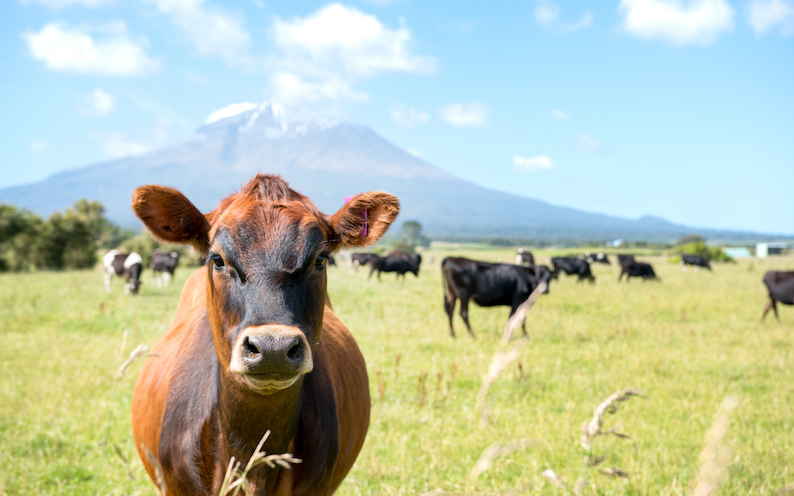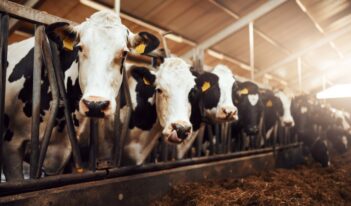
New Zealand grapples with balancing agricultural interests when reducing greenhouse gas emissions.
New Zealand—a country with more cows and sheep than people—prides itself on producing and exporting high-quality grass-fed beef and lamb. Yet, despite New Zealand farmers being among the most productive and efficient in the world, they produce nearly half of the country’s total greenhouse gas emissions.
The main source of such emissions stems from methane produced by belching cattle and sheep. Methane is initially very damaging, but it leaves the atmosphere much faster than long-lived gases such as carbon dioxide. The New Zealand government has been confronted by the issue of how to treat methane emissions as it seeks to transition New Zealand to a low-emissions economy.
Last week, the New Zealand Parliament passed a “zero carbon” bill into law with near-unanimous support. The law’s purpose is “to provide a framework by which New Zealand can develop and implement clear and stable climate change policies that contribute to the global effort under the Paris Agreement.”
The new law sets a target into legislation to reduce long-lived greenhouse gases to net zero by 2050. This target does not apply to methane, with the law setting a separate methane reduction rate of 10 percent by 2030 and a provisional reduction target of between 24 percent and 47 percent by 2050.
This “split gases” approach addresses the agricultural sector’s concern that a net zero target for all gases would require farmers to reduce methane to unjustified levels. When introducing the bill into Parliament, Prime Minister Jacinda Ardern explained that “agriculture is incredibly important to New Zealand, but it also needs to be part of the solution. That is why we have listened to the science and also heard the industry and created a specific target for biogenic methane.”
An independent Climate Change Commission—also established under the new legislation—will review the provisional 2050 methane target. The Commission will also provide climate change advice, recommend five-yearly interim emissions budgets, and monitor government action.
The reduction targets were a controversial issue during the bill’s passage through Parliament. Some environmental groups argued that there should be one net zero 2050 target. They pointed to the fact that 91 percent of respondents to the government’s initial policy proposal wanted one target across all greenhouse gases.
A split gases approach is, however, consistent with recommendations from the Parliamentary Commissioner for the Environment and the New Zealand Productivity Commission. The Commissioner considered that even though methane levels need to be reduced, this would not need to be to zero if the government’s aim is to stabilize methane’s contribution to warming.
Farming groups supported the split gases approach, but they argued that the provisional targets were too high and go beyond what is necessary to achieve no additional warming. Farmers were concerned that the targets will harm New Zealand livestock exporters and advantage less emissions-efficient foreign farmers.
The methane targets largely align with modeling undertaken by the Biological Emissions Reference Group, a research group comprised of government agencies and agricultural organizations, which suggested that, when all mitigation options are combined, overall biological emissions could potentially be reduced by 10 percent to 21 percent by 2030 and 22 percent to 48 percent in 2050.
Despite supporting the bill’s passage into law, New Zealand’s center-right National Party still opposes the current methane reduction targets. The Party’s leader, Simon Bridges, stated that, if elected into power, the National Party will change the law so that the independent Climate Change Commission can recommend a target.
Beyond setting a methane reduction target, the New Zealand government has also grappled with how to implement the policies required to effect methane reductions. New Zealand’s primary regulatory tool to address climate change is its emissions trading scheme. Established in 2008, the scheme places a price on each ton of greenhouse gas emitted by all sectors of the economy, except agriculture.
The Interim Climate Change Commission recommended that agriculture be brought into the scheme for 2025 through a farm-level levy and rebate scheme. Until the scheme could be implemented, the Interim Commission recommended that emissions be priced at the processor level for 2020. In line with a government coalition agreement, farmers’ obligations would be subject to a 95 percent discount.
The Interim Commission’s proposal was criticized by farming groups, who wished to keep agriculture out of the emissions trading scheme altogether. The sector argued that farmers need more time to measure emissions sources, develop the technologies needed to mitigate and offset on-farm emissions, and develop appropriate pricing mechanisms. Farmers contended that due to the diversity of the primary sector, a “one-size-fits all” approach was not appropriate and that imposing a broad-based tax at the processor level would do nothing to reduce emissions.
The New Zealand government recently agreed with the primary sector, announcing that the parties will now work together to measure and price emissions at the farm level. There is a backstop, however, in that if the parties have not agreed on an alternative pricing mechanism by 2025, agriculture will enter the emissions trading scheme with a 95 percent discount. Furthermore, if the sector is not making enough progress by 2022, the government can bring agriculture into the emissions trading scheme before 2025.
The government’s announcement has received mixed stakeholder responses. The agriculture sector welcomed the government’s announcement, saying that the agreement provides the best opportunity to develop a “practical and simple” framework for farmers, “rewards positive change,” and “supports the sector to reduce and offset farming’s emissions.” Environmental groups such as Greenpeace New Zealand have been less welcoming, accusing the government of buckling to lobbying pressure.
Although New Zealand contributes less than 0.2 percent of all global emissions, its per person rate of greenhouse gas emissions is one of the highest in the world for industrial countries. With the zero carbon bill now law, focus will turn to whether the farming sector can effectively reduce emissions. If so, New Zealand has an opportunity to lead the way for other farming nations on how to tackle agriculture’s environmental costs.



